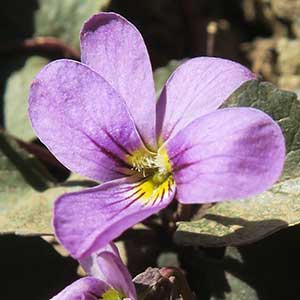Viola flettii
Viola pedatifida
Flett's violet, Olympic violet, rock violet
crow-foot violet, prairie or crowfoot or larkspur violet, prairie violet, violette pédatifide
1–3, ascending to erect, mostly glabrous, on caudex from fleshy rhizome.
basal and cauline;
basal: 1–3;
stipules linear-lanceolate, margins entire or with glandular processes, apex acuminate;
petiole 1.5–9.7 cm, mostly glabrous;
blade purple-tinted and –veined, broadly reniform to ovate, 0.9–2.4 × 1.2–4 cm, base cordate, margins finely crenate-serrate, eciliate, apex acute to obtuse, surfaces glabrous or sparsely pubescent along veins adaxially;
cauline similar to basal except: stipules ovate to lanceolate, margins entire or shallowly laciniate;
petiole 0.7–5.9 cm, usually glabrous;
blade 0.8–2.1 × 1.2–3.1 cm.
basal, 2–11, ascending to erect, 5–9-lobed;
stipules linear-lanceolate, margins entire, apex acute;
petiole 3–16 cm, pubescent;
blade similar in width and shape, lobes lanceolate, spatulate, falcate, or linear, 1–7 × 2–8 cm, base truncate to reniform, margins entire, ciliate, apex acute to obtuse, mucronulate, surfaces pubescent, hairs sometimes concentrated on veins.
1.8–7.1 cm, usually glabrous.
5–18 cm, glabrous or pubescent.
sepals lanceolate, margins eciliate, auricles 0.5–1.5 mm;
petals soft reddish violet on both surfaces, all with yellow area basally, lower 3 dark violet-veined, lateral 2 bearded, lowest with white around yellow area, 10–15 mm, spur yellow, gibbous, 0.5–2 mm;
style head bearded; cleistogamous flowers axillary.
sepals lanceolate to ovate, margins ciliate or eciliate, auricles 1–2 mm;
petals light to soft reddish violet on both surfaces, lower 3 white basally, dark violet-veined, lateral 2 and lowest usually bearded, lowest 10–25 mm, spur same color as petals, gibbous, 2–3 mm;
style head beardless; cleistogamous flowers on ascending to erect peduncles.
± spherical, 5–9 mm, glabrous.
ellipsoid, 10–15 mm, glabrous.
dark brown to brownish purple, 2.5–3 mm.
beige, mottled to bronze, 1.5–2.5 mm.
= 54.
Viola flettii
Viola pedatifida
Viola flettii is endemic to the Olympic Mountains of northwestern Washington. C. S. McCreary (2005) noted that although morphologically and ecologically distinct, V. cuneata, V. flettii, and V. ocellata are closely related.
(Discussion copyrighted by Flora of North America; reprinted with permission.)
Viola pedatifida was reported historically from, and recently rediscovered in, the Appalachian shale barrens of Virginia (T. Wieboldt, pers. comm.).
Viola pedatifida reportedly hybridizes with V. sororia (= V. ×bernardii Greene).
(Discussion copyrighted by Flora of North America; reprinted with permission.)


